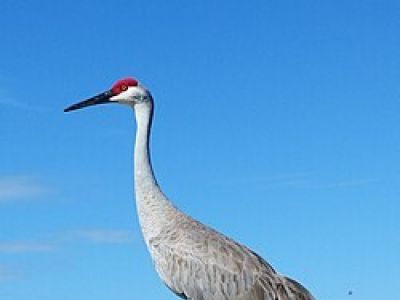B-SACR-Sandhill Crane

Sandhill Crane
Grus canadensis
- Phylum: Craniata
- Class: Aves
- Order: Gruiformes
- Family: Gruidae
The sandhill crane (Antigone canadensis) is a species of large cranes of North America and extreme northeastern Siberia. The common name of this bird refers to its habitat
General Information
Key Habitat Features
Roosting/staging areas with level terrain. Shallow water where the shoreline is sparsely vegetated or devoid of vegetation.
Peace Region migratory staging areas: Nig Creek, Cecil Lake and Liard Hot Springs.
Confirmed breeder in Fort Nelson Lowlands.
Nests in isolated bogs, marshes, wetlands and wet meadows on the ground or over water among emergent vegetation or thick shrubs.
Objectives
Minimize disturbance during the breeding and migratory season.
Maintain nesting habitat and migratory staging areas throughout all seasons.
Maintain desired plant communities and key habitat features.
Planning and Operational Measures
All Activities
Identify key habitat features using appropriate measures (i.e. QP direction, desktop review, field confirmation, etc) and plan activities within the operating area accordingly.
Time works such that they occur outside of the critical timing window.
Linear Features:
Minimize access to breeding and staging areas.
All Activities
Undertake construction and operation of oil and gas activities in a manner that minimizes impacts to desired plant communities and key habitat features.
Maintain sufficient distance to avoid flushing birds from occupied staging areas.
Timing considerations when working within identified habitat:
Avoid disturbance and/or clearing activities during the critical timing window from April 1 to September 21.
Note: Primary spring migratory period late April to early May, and fall migration in second and third weeks of September.
Linear Features:
Avoid creating access and/or disturbance within spring and fall staging grounds.